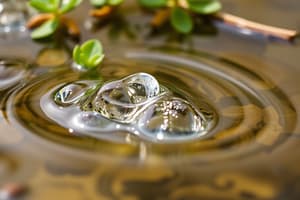Podcast
Questions and Answers
What is high specific heat?
What is high specific heat?
- Water can move up a small tube.
- Water resists changes in temperature. (correct)
- Water molecules sticking to each other.
- Water sticks to other things.
What is cohesion?
What is cohesion?
When water molecules stick to each other.
What is adhesion?
What is adhesion?
When water sticks to other things.
What is capillary action?
What is capillary action?
What are the three properties of water?
What are the three properties of water?
What is the balanced equation of a water molecule?
What is the balanced equation of a water molecule?
What is polarity?
What is polarity?
Why is ice less dense than water?
Why is ice less dense than water?
Why is it important that ice floats instead of sinks?
Why is it important that ice floats instead of sinks?
Why can water cause so many things to dissolve?
Why can water cause so many things to dissolve?
How does a raindrop on a window illustrate cohesion and adhesion?
How does a raindrop on a window illustrate cohesion and adhesion?
How can a penny skipper float on water?
How can a penny skipper float on water?
How does soapy water break the surface tension?
How does soapy water break the surface tension?
Flashcards are hidden until you start studying
Study Notes
Unique Properties of Water
-
High Specific Heat: Water has a high specific heat, meaning it resists changes in temperature. Increased heat energy is required to raise its temperature, helping regulate cellular conditions.
-
Cohesion: Water molecules exhibit cohesion by sticking to each other, creating surface tension. This property allows small organisms, like spiders, to walk on water's surface.
-
Adhesion: Water molecules demonstrate adhesion by sticking to other surfaces. This property is essential for plants, as it facilitates the movement of water from roots to leaves.
-
Capillary Action: Water can travel upward through narrow spaces, like a straw, due to adhesion and gravity. This action is crucial for transporting water within plants.
-
Properties of Water: The three fundamental properties of water include Capillary Action, Cohesion & Adhesion, and High Specific Heat.
-
Balanced Equation of Water: The formation of water molecules is represented by the chemical equation: 2H₂ + O₂ → 2H₂O.
-
Covalent Bond Formation: Water molecules form covalent bonds through the sharing of electrons between hydrogen and oxygen.
-
Polarity: Water is polar, with oxygen having a higher electronegativity than hydrogen, giving it a slight negative charge. This polarity causes hydrogen bonds to form, with the positive hydrogen attracted to the negative oxygen.
-
Density of Ice: Ice is less dense than liquid water because it expands when frozen, resulting in greater volume and lower mass.
-
Importance of Ice Floating: Ice floats on water, preventing bodies of water from freezing solid. This phenomenon ensures that aquatic life can survive beneath a frozen surface.
-
Solvent Properties: Water's polarity allows it to dissolve many substances. Chloride (Cl) is attracted to hydrogen, while sodium (Na) is attracted to oxygen, facilitating the process of dissolution.
-
Raindrop Dynamics: A raindrop on a window illustrates cohesion (water sticking to itself) and adhesion (water sticking to the window), highlighting the interactions between different surfaces.
-
Penny Skipper's Floating: The penny skipper uses cohesion to float on water, where the attraction between hydrogen and oxygen creates surface tension, forming a film.
-
Effect of Soap on Surface Tension: Soapy water disrupts surface tension due to soap's non-polar nature, leading to a reduction in cohesion. This causes insects not to float and ultimately fall through the water.
Studying That Suits You
Use AI to generate personalized quizzes and flashcards to suit your learning preferences.





